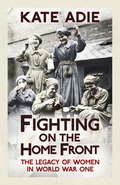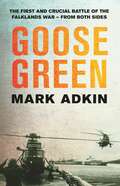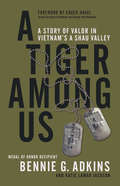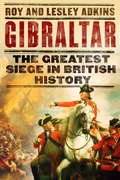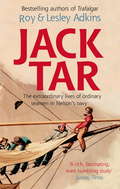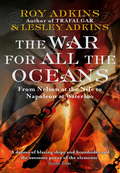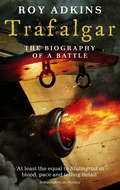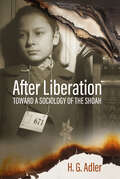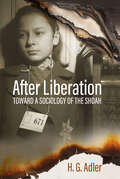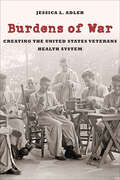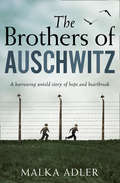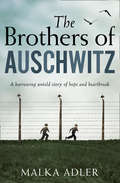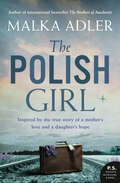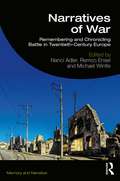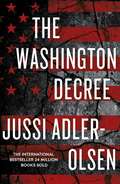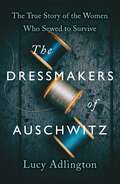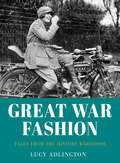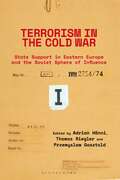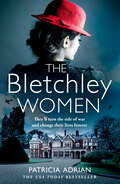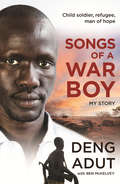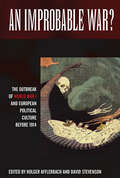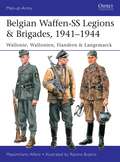- Table View
- List View
Fighting on the Home Front: The Legacy of Women in World War One
by Kate Adie'History at its most celebratory' Daily Telegraph'Adie uses her journalistic eye for personal stories and natural compassion to create a book definitely worthy of her heroines' Big Issue'Fascinating, very readable . . . provides a complete wartime women's history' Discover Your History* * * * * *Bestselling author and award-winning former BBC Chief News Correspondent Kate Adie reveals the ways in which women's lives changed during World War One and what the impact has been for women in its centenary year.IN 1914 THE WORLD CHANGED forever. When World War One broke out and a generation of men went off to fight, bestselling author and From Our Own Correspondent presenter Kate Adie shows how women emerged from the shadows of their domestic lives.Now a visible force in public life, they began to take up essential roles - from transport to policing, munitions to sport, entertainment, even politics. They had finally become citizens, a recognised part of the war machine, acquiring their own rights and often an independent income.The former BBC Chief News Correspondent charts the seismic move towards equal rights with men that began a century ago and through unique first-hand research shows just how momentous the achievements of those pioneering women were.This is history at its best - a vivid, compelling account of the women who helped win the war as well as a revealing assessment of their legacy for women's lives today.
Goose Green: The first crucial battle of the Falklands War
by Mark AdkinReissued for the 40th anniversary of the Falklands conflictThe most in-depth and powerful account yet published of the first crucial clash of the Falklands war - told from both sides.'Thorough and exhaustive' Daily Telegraph'An excellent and fast paced narrative' Michael McCarthy, historical battlefield guideGoose Green was the first land battle of the Falklands War. It was also the longest, the hardest-fought, the most controversial and the most important to win. What began as a raid became a vicious, 14-hour infantry struggle, in which 2 Para - outnumbered, exhausted, forced to attack across open ground in full daylight, and with inadequate fire support - lost their commanding officer, and almost lost the action.This is the only full-length, detailed account of this crucial battle. Drawing on the eye-witness accounts of both British and Argentinian soldiers who fought at Goose Green, and their commanders' narratives, it has become the definitive account of most important and controversial land battle of the Falklands War. A compelling story of men engaged in a battle that hung in the balance for hours, in which Colonel 'H' Jones' solo charge against an entrenched enemy won him a posthumous V.C., and which for both sides was a gruelling and often terrifying encounter.
A Tiger among Us: A Story of Valor in Vietnam's A Shau Valley
by Bennie G. Adkins Katie Lamar JacksonForeword by Chuck Hagel, former Secretary of Defense and Senator from NebraskaAdaptable. Cunning. Ferocious. Fearless. The Indochinese tiger is just one of the formidable predators roaming Vietnam's jungle. In 1966 a small band of US Special Forces soldiers--most especially Bennie Adkins--spent four grueling days facing down the "tiger" among them.While the rain and mist of an early March moved over the valley, then-Sergeant First Class Bennie Adkins and sixteen other Green Berets found themselves holed up in an undermanned and unfortified position at Camp A Shau, a small training and reconnaissance camp located right next to the infamous Ho Chi Minh Trail, North Vietnam's major supply route. And with the rain came the North Vietnamese Army in force.Surrounded 10-to-1, the Green Berets endured constant mortar and rifle fire, direct assaults, treasonous allies, and volatile jungle weather. But there was one among them who battled ferociously, like a tiger, and when they finally evacuated, he carried the wounded to safety. Forty-eight years later, Command Sergeant Major Bennie Adkins's valor was recognized when he received this nation's highest military award, the Medal of Honor.Filled with the sights, smells, and sounds of a raging battle fought in the middle of a tropical forest, A Tiger among Us is a riveting tale of bravery, valor, skill, and resilience.
Gibraltar: The Greatest Siege in British History
by Lesley Adkins Roy AdkinsFor over three and a half years, from 1779 to 1783, the tiny territory of Gibraltar was besieged and blockaded, on land and at sea, by the overwhelming forces of Spain and France. It became the longest siege in British history, and the obsession with saving Gibraltar was blamed for the loss of the American colonies in the War of Independence. Located between the Mediterranean and Atlantic, on the very edge of Europe, Gibraltar was a place of varied nationalities, languages, religions and social classes. During the siege, thousands of soldiers, civilians and their families withstood terrifying bombardments, starvation and diseases. Very ordinary people lived through extraordinary events, from shipwrecks and naval battles to an attempted invasion of England and a daring sortie out of Gibraltar into Spain. Deadly innovations included red-hot shot, shrapnel shells and a barrage from immense floating batteries.This is military and social history at its best, a story of soldiers, sailors and civilians, with royalty and rank-and-file, workmen and engineers, priests, prisoners-of-war, spies and surgeons, all caught up in a struggle for a fortress located on little more than two square miles of awe-inspiring rock. Gibraltar: The Greatest Siege in British History is an epic page-turner, rich in dramatic human detail - a tale of courage, endurance, intrigue, desperation, greed and humanity. The everyday experiences of all those involved are brought vividly to life with eyewitness accounts and expert research.
Jack Tar: Life in Nelson's Navy
by Lesley Adkins Roy AdkinsThe Royal Navy to which Admiral Lord Nelson sacrificed his life depended on thousands of sailors and marines to man the great wind-powered wooden warships. Drawn from all over Britain and beyond, often unwillingly, these ordinary men made the navy invincible through skill, courage and sheer determination. Yet their contribution is frequently overlooked, while the officers became celebrities. JACK TAR gives these forgotten men a voice in an exciting, enthralling, often unexpected and always entertaining picture of what their life was really like during this age of sail. Through personal letters, diaries and other manuscripts, the emotions and experiences of these people are explored, from the dread of press-gangs, shipwreck and disease, to the exhilaration of battle, grog, prize money and prostitutes. JACK TAR is an authoritative and gripping account that will be compulsive reading for anyone wanting to discover the vibrant and sometimes stark realities of this wooden world at war.
The War For All The Oceans: From Nelson at the Nile to Napoleon at Waterloo (Playaway Adult Nonfiction Ser.)
by Lesley Adkins Roy AdkinsAs France emerged from revolution, a young general named Napoleon Bonaparte invaded Egypt, hoping next to march overland to India. It would not happen. Britain swung her forces into action to battle for control of the world's sea-lanes and thus all international trade. The Battle of the Nile and then at Acre were the first sallies in what would be fifteen years of bitter fighting. It was a war won at sea, and by the time of Waterloo Britain had gained control and possessed the foundations of her vast empire.Brought vividly to life through the words and stories of the ordinary people caught up in the conflict, this is a sweeping history of the years of naval warfare that set the balance of power in Europe for the following century. Taking in gallant duels, bloody battles between huge fleets, amphibious assaults, daring coastal raids, and the subtleties of espionage and naval intelligence, this global conflict truly was THE WAR FOR ALL THE OCEANS.
Trafalgar: The Biography of a Battle
by Roy AdkinsThis is the true story of the Battle of Trafalgar, Britain's most significant sea battle, as seen through the smoke-hazed gunports of the fighting ships. In an atmosphere of choking fumes from cannon and musket fire, amid noise so intense it was almost tangible, the crews of the British, French and Spanish ships did their best to carry out their allotted tasks. For over five hours they were in constant danger from a terrifying array of iron and lead missiles fired from enemy guns, as well as the deadly wooden splinters smashed from the ships' hulls by the cannon-balls. While the men manoeuvred the ships and kept the cannons firing, the women helped the surgeons tend the sick or helped the boys - the 'powder monkeys' - in the hazardous job of carrying gunpowder cartridges from the central magazine to the gun decks. Trafalgar set the seal on British naval supremacy, which became the mainspring for the growth of the British Empire, and in the short term not only prevented Napoleon from invading Britain, but also enabled Britain and its Continental allies to mount the campaign that would eventually defeat the French Emperor: without Trafalgar there would be no Waterloo.
After Liberation: Toward a Sociology of the Shoah<br/>Selected Essays
by H. G. Adler Jeremy AdlerH.G. Adler (1910–1988) was one of the founding figures of Holocaust scholarship whose monumental monograph Theresienstadt 1941-1945. The Face of a Coerced Community (1955; 1960) was the first study to present a fully documented account of the Final Solution. This collection gathers together, for the first time in English, some of Adler’s most important scholarly essays on the Shoah and connected themes. Ideas raised for the first time in his book on Theresienstadt are here taken up and developed at greater length, new accents are set, and new themes are explored. Spanning his thought across three decades they focus on the fate of the ‘coerced’ human being and reflect on freedom, enslavement, terror, concentration camps, persecution, the mass society, dread, loneliness, and ideology.
After Liberation: Toward a Sociology of the Shoah<br/>Selected Essays
by H. G. Adler Jeremy AdlerH.G. Adler (1910–1988) was one of the founding figures of Holocaust scholarship whose monumental monograph Theresienstadt 1941-1945. The Face of a Coerced Community (1955; 1960) was the first study to present a fully documented account of the Final Solution. This collection gathers together, for the first time in English, some of Adler’s most important scholarly essays on the Shoah and connected themes. Ideas raised for the first time in his book on Theresienstadt are here taken up and developed at greater length, new accents are set, and new themes are explored. Spanning his thought across three decades they focus on the fate of the ‘coerced’ human being and reflect on freedom, enslavement, terror, concentration camps, persecution, the mass society, dread, loneliness, and ideology.
After Liberation: Toward a Sociology of the Shoah<br/>Selected Essays
by H. G. Adler Jeremy AdlerH.G. Adler (1910–1988) was one of the founding figures of Holocaust scholarship whose monumental monograph Theresienstadt 1941-1945. The Face of a Coerced Community (1955; 1960) was the first study to present a fully documented account of the Final Solution. This collection gathers together, for the first time in English, some of Adler’s most important scholarly essays on the Shoah and connected themes. Ideas raised for the first time in his book on Theresienstadt are here taken up and developed at greater length, new accents are set, and new themes are explored. Spanning his thought across three decades they focus on the fate of the ‘coerced’ human being and reflect on freedom, enslavement, terror, concentration camps, persecution, the mass society, dread, loneliness, and ideology.
Burdens of War: Creating the United States Veterans Health System (Reconfiguring American Political History)
by Jessica L. AdlerIn the World War I era, veterans fought for a unique right: access to government-sponsored health care. In the process, they built a pillar of American social policy. Burdens of War explores how the establishment of the veterans;€™ health system marked a reimagining of modern veterans;€™ benefits and signaled a pathbreaking validation of the power of professionalized institutional medical care.Adler reveals that a veterans;€™ health system came about incrementally, amid skepticism from legislators, doctors, and army officials concerned about the burden of long-term obligations, monetary or otherwise, to ex-service members. She shows how veterans;€™ welfare shifted from centering on pension and domicile care programs rooted in the nineteenth century to direct access to health services. She also traces the way that fluctuating ideals about hospitals and medical care influenced policy at the dusk of the Progressive Era; how race, class, and gender affected the health-related experiences of soldiers, veterans, and caregivers; and how interest groups capitalized on a tense political and social climate to bring about change.The book moves from the 1910s;¢;‚¬;€?when service members requested better treatment, Congress approved new facilities and increased funding, and elected officials expressed misgivings about who should have access to care;¢;‚¬;€?to the 1930s, when the economic crash prompted veterans to increasingly turn to hospitals for support while bureaucrats, politicians, and doctors attempted to rein in the system. By the eve of World War II, the roots of what would become the country;€™s largest integrated health care system were firmly planted and primed for growth. Drawing readers into a critical debate about the level of responsibility America bears for wounded service members, Burdens of War is a unique and moving case study.
Burdens of War: Creating the United States Veterans Health System (Reconfiguring American Political History)
by Jessica L. AdlerIn the World War I era, veterans fought for a unique right: access to government-sponsored health care. In the process, they built a pillar of American social policy. Burdens of War explores how the establishment of the veterans;€™ health system marked a reimagining of modern veterans;€™ benefits and signaled a pathbreaking validation of the power of professionalized institutional medical care.Adler reveals that a veterans;€™ health system came about incrementally, amid skepticism from legislators, doctors, and army officials concerned about the burden of long-term obligations, monetary or otherwise, to ex-service members. She shows how veterans;€™ welfare shifted from centering on pension and domicile care programs rooted in the nineteenth century to direct access to health services. She also traces the way that fluctuating ideals about hospitals and medical care influenced policy at the dusk of the Progressive Era; how race, class, and gender affected the health-related experiences of soldiers, veterans, and caregivers; and how interest groups capitalized on a tense political and social climate to bring about change.The book moves from the 1910s;¢;‚¬;€?when service members requested better treatment, Congress approved new facilities and increased funding, and elected officials expressed misgivings about who should have access to care;¢;‚¬;€?to the 1930s, when the economic crash prompted veterans to increasingly turn to hospitals for support while bureaucrats, politicians, and doctors attempted to rein in the system. By the eve of World War II, the roots of what would become the country;€™s largest integrated health care system were firmly planted and primed for growth. Drawing readers into a critical debate about the level of responsibility America bears for wounded service members, Burdens of War is a unique and moving case study.
The Brothers of Auschwitz
by Malka AdlerMy brother’s tears left a delicate, clean line on his face. I stroked his cheek, whispered, it’s really you…
The Brothers of Auschwitz
by Malka AdlerMy brother’s tears left a delicate, clean line on his face. I stroked his cheek, whispered, it’s really you …
The Polish Girl
by Malka AdlerIn the eye of the war That tore the world apart A mother wants a son A daughter needs a mother
Narratives of War: Remembering and Chronicling Battle in Twentieth-Century Europe (Memory and Narrative)
by Nanci Adler Remco Ensel Michael WintleNarratives of War considers the way war and battle are remembered and narrated across space and time in Europe in the twentieth century. The book reflects on how narratives are generated and deployed, and on their function as coping mechanisms, means of survival, commemorative gestures, historical records and evidence. The contributions address such issues as the tension and discrepancy between memory and the official chronicling of war, the relationship between various individuals’ versions of war narratives and the ways in which events are brought together to serve varied functions for the narrators and their audiences. Drawing upon the two World Wars, the Spanish Civil War and the ex-Yugoslav wars, and considering narrative genres that include film, schoolbooks, novels, oral history, archives, official documents, personal testimony and memoirs, readers are introduced to a range of narrative forms and examples that highlight the complexity of narrative in relation to war. Approached from a multidisciplinary perspective, and taken together, analysis of these narratives contributes to our understanding of the causes, experience, dynamics and consequences of war, making it the ideal book for those interested in twentieth-century war history and the history of memory and narrative.
Narratives of War: Remembering and Chronicling Battle in Twentieth-Century Europe (Memory and Narrative)
by Nanci Adler Remco Ensel Michael WintleNarratives of War considers the way war and battle are remembered and narrated across space and time in Europe in the twentieth century. The book reflects on how narratives are generated and deployed, and on their function as coping mechanisms, means of survival, commemorative gestures, historical records and evidence. The contributions address such issues as the tension and discrepancy between memory and the official chronicling of war, the relationship between various individuals’ versions of war narratives and the ways in which events are brought together to serve varied functions for the narrators and their audiences. Drawing upon the two World Wars, the Spanish Civil War and the ex-Yugoslav wars, and considering narrative genres that include film, schoolbooks, novels, oral history, archives, official documents, personal testimony and memoirs, readers are introduced to a range of narrative forms and examples that highlight the complexity of narrative in relation to war. Approached from a multidisciplinary perspective, and taken together, analysis of these narratives contributes to our understanding of the causes, experience, dynamics and consequences of war, making it the ideal book for those interested in twentieth-century war history and the history of memory and narrative.
The Washington Decree: A Novel
by Jussi Adler-OlsenThe New York Times and #1 internationally bestselling author of the Department Q series is back, with a terrifyingly relevant stand-alone novel about an America in chaos. A NO. 1 INTERNATIONAL BESTSELLEROVER 18 MILLION COPIES SOLDWINNER OF THE GLASS KEY AWARD"The president has gone way too far. . . . These are practically dictatorial methods we're talking about." When Democratic Senator Bruce Jansen is elected president of the United States, it is a personal victory for Dorothy "Dottie" Rogers. She has secured a job in the White House, has proved to her Republican father that she was right to support Jansen, and is proud to see the rise of an intelligent, inspiring leader who shares her ideals. But the triumph is short-lived: Jansen's pregnant wife is assassinated on election night, and the alleged mastermind behind the shooting is none other than Dottie's own father. When Jansen ascends to the White House, he is a changed man, determined to end gun violence by any means necessary. Rights are taken away as quickly as weapons. Checkpoints and roadblocks destroy infrastructure. The media is censored. Militias declare civil war on the government. The country is in chaos, and Dottie's finds herself fighting for the life of her father, who just may be innocent.
The Dressmakers of Auschwitz: The True Story of the Women Who Sewed to Survive
by Lucy Adlington'Lucy Adlington tells of the horrors of the Nazi occupation and the concentration camps from a fascinating and original angle. She introduces us to a little known aspect of the period, highlighting the role of clothes in the grimmest of societies imaginable and giving an insight into the women who stayed alive by stitching' - Alexandra Shulman, author of Clothes...and other things that matter'An utterly absorbing, important and unique historical read' - Judy Batalion, NY Times bestselling author of The Light of Our Days: The Untold Story of Women Resistance Fighters in Hitler's GhettosThe powerful chronicle of the women who used their sewing skills to survive the Holocaust, stitching beautiful clothes at an extraordinary fashion workshop created within one of the most notorious WWII death camps. At the height of the Holocaust twenty-five young inmates of the infamous Auschwitz-Birkenau concentration camp - mainly Jewish women and girls - were selected to design, cut, and sew beautiful fashions for elite Nazi women in a dedicated salon. It was work that they hoped would spare them from the gas chambers. This fashion workshop - called the Upper Tailoring Studio - was established by Hedwig Höss, the camp commandant's wife, and patronized by the wives of SS guards and officers. Here, the dressmakers produced high-quality garments for SS social functions in Auschwitz, and for ladies from Nazi Berlin's upper crust. Drawing on diverse sources - including interviews with the last surviving seamstress - The Dressmakers of Auschwitz follows the fates of these brave women. Their bonds of family and friendship not only helped them endure persecution, but also to play their part in camp resistance. Weaving the dressmakers' remarkable experiences within the context of Nazi policies for plunder and exploitation, historian Lucy Adlington exposes the greed, cruelty, and hypocrisy of the Third Reich and offers a fresh look at a little-known chapter of World War II and the Holocaust.
Great War Fashion: Tales from the History Wardrobe
by Lucy AdlingtonImagine ‘stepping into someone else’s shoes’. Walking back in time a century ago, which shoes would they be? A pair of silk sensations costing thousands of pounds designed by Yantonnay of Paris or wooden clogs with metal cleats that spark on the cobbles of a factory yard? Will your shoes be heavy with mud from trudging along duckboards between the tents of a frontline hospital… or stuck with tufts of turf from a football pitch? Will you be cloaked in green and purple, brandishing a ‘Votes for Women’ banner or will you be the height of respectability, restricted by your thigh-length corset? Great War Fashion opens the woman’s wardrobe in the years before the outbreak of war to explore the real woman behind the stiff, mono-bosomed ideal of the Edwardian Society lady draped in gossamer gowns, and closes it on a new breed of women who have donned trousers and overalls to feed the nation’s guns in munitions factories and who, clad in mourning, have loved and lost a whole generation of men. The journey through Great War Fashion is not just about the changing clothes and fashions of the war years, but much more than that – it is a journey into the lives of the women who lived under the shadow of war and were irrevocably changed by it. At times, laugh-out-loud funny and at others, bringing you to tears, Lucy Adlington paints a unique portrait of an inspiring generation of women, brought to life in rare and stunning images.
Terrorism in the Cold War: State Support in Eastern Europe and the Soviet Sphere of Influence
by Adrian Hänni, Thomas Riegler and Przemyslaw GasztoldAccounts of the relationships between states and terrorist organizations in the Cold War era have long been shaped by speculation, a lack of primary sources and even conspiracy theories. In the last few years, however, things have evolved rapidly. Using a wide range of case studies including the KGB's Abduction Program, Polish Military Intelligence and North Korea's 'Terrorism and Counterterrorism', this book sheds new light on the relations between state and terrorist actors, allowing for a fresh and much more insightful assessment of the contacts, dealings, agreements and collusion with terrorist organizations undertaken by state actors on both sides of the Iron Curtain.This book presents the current state of research and provides an assessment of the nature, motives, effects, and major historical shifts of the relations between individual states and terrorist organizations. The articles collected demonstrate that these state-terrorism relationships were not only much more ambiguous than much of the older literature had suggested but are, in fact, crucial for the understanding of global political history in the Cold War era.
The Bletchley Women
by Patricia AdrianA stunning new historical novel perfect for fans of Kate Quinn and Dinah Jeffries!
Songs of a War Boy: The bestselling biography of Deng Adut - a child soldier, refugee and man of hope
by Deng Thiak Adut Ben MckelveyThe true story of Deng Adut - Sudanese child soldier, refugee, man of hopeDeng Adut's family were farmers in South Sudan when a brutal civil war altered his life forever. At six years old, his mother was told she had to give him up to fight. At the age most Australian children are starting school , Deng was conscripted into the Sudan People's Liberation Army. He began a harsh, relentless military training that saw this young boy trained to use an AK-47 and sent into battle. He lost the right to be a child. He lost the right to learn.The things Deng saw over those years will stay with him forever. He suffered from cholera, malaria and numerous other debilitating illnesses but still he had to fight. A child soldier is expected to kill or be killed and Deng almost died a number of times. He survived being shot in the back. The desperation and loneliness was overwhelming. He thought he was all alone. But Deng was rescued from war by his brother John. Hidden in the back of a truck, he was smuggled out of Sudan and into Kenya. Here he lived in refugee camps until he was befriended by an Australian couple. With their help and the support of the UN, Deng Adut came to Australia as a refugee. Despite physical injuries and mental trauma he grabbed the chance to make a new life. He worked in a local service station and learnt English watching The Wiggles. He taught himself to read and started studying at TAFE. In 2005 he enrolled in a Bachelor of Law at Western Sydney University. He became the first person in his family to graduate from university. This is an inspiring story of a man who has overcome deadly adversity to become a lawyer and committed worker for the disenfranchised, helping refugees in Western Sydney. It is an important reminder of the power of compassion and the benefit to us all when we open our doors and our hearts to fleeing war, persecution and trauma.
An Improbable War?: The Outbreak of World War I and European Political Culture before 1914
by Holger Afflerbach David StevensonThe First World War has been described as the "primordial catastrophe of the twentieth century." Arguably, Italian Fascism, German National Socialism and Soviet Leninism and Stalinism would not have emerged without the cultural and political shock of World War I. The question why this catastrophe happened therefore preoccupies historians to this day. The focus of this volume is not on the consequences, but rather on the connection between the Great War and the long 19th century, the short- and long-term causes of World War I. This approach results in the questioning of many received ideas about the war's causes, especially the notion of "inevitability."
Belgian Waffen-SS Legions & Brigades, 1941–1944: Wallonie, Wallonien, Flandern & Langemarck (Men-at-Arms)
by Massimiliano AfieroFrom the German occupation of Belgium in May 1940, Flemish recruits from northern Belgium – considered by the Nazis to be 'Germanic' – were accepted individually into Waffen-SS units. From Hitler's invasion of the USSR in June 1941, additional recruits from the French-speaking south (Wallonia) were drafted. Both communities formed volunteer 'Legions', to fight (according to Goebbels' propaganda machine) 'for European civilization against the Bolshevik threat'; these were a Flemish Legion in the Waffen-SS and a Walloon Legion in the German Army. Both served on the Russian Front in 1942-43; the Walloon Legion was then also transferred into the Waffen-SS, and the decorated Walloon officer Leon Degrelle became a publicized 'poster boy' for foreign SS volunteers. Both Legions were then redesignated as SS Assault Brigades, and thereafter saw extremely hard fighting in the Ukraine and on the Baltic front. In autumn 1944, their survivors were withdrawn from the front and incorporated into two new understrength SS Divisions, 27. 'Langemarck' and 28. 'Wallonien'.This new account, featuring detailed colour plates of uniform and insignia, recounts the battle history of the French and Flemish-speaking Belgian SS, up to their final transformation into full divisions in the winter of 1944/45.
